Analysis of the Thermal and Cooling Energy Performance of the Perimeter Zones in an Office Building
Abstract
:1. Introduction
2. The Air Barrier System by Utilizing the Underfloor Air Distribution System
3. Materials and Methods
3.1. Building Selection
3.2. Energy Simulation
4. Results
4.1. The Comparison between the Energy Simulation and the Monthly Energy Consumption
4.2. The Analysis of Cooling Loads by Solar Radiation
4.3. Field Measurements
4.4. HVAC System for Reducing the Loads
4.5. Measurements for Thermal Performance in the Perimeter Zone
4.6. The Analysis of the Measurement Results
5. Discussion
6. Conclusions
- Among building orientations, the biggest cooling load was observed in the perimeter zones facing the west façade through the windows during the summer and winter through the energy simulation and field measurements;
- According to the measurement results, the highest temperature was observed at the internal surface of the windows during the winter, and the peak temperatures were 35 °C and 40 °C on the fifth and tenth floors, respectively. For the perimeter and core zones, the temperature was stably maintained on these two floors. The average temperatures for the perimeter zones and the average temperatures were about 19 °C and 25 °C on the fifth and tenth floors, respectively;
- The heat generated by the sun on the west façade during the winter was effectively reduced by the air barrier system. However, more effective ways of reducing the cooling loads during the summer are required.
Author Contributions
Funding
Institutional Review Board Statement
Informed Consent Statement
Data Availability Statement
Conflicts of Interest
References
- Oh, M.; Jang, K.M.; Kim, Y. Empirical analysis of building energy consumption and urban form in a large city: A case of seoul, south korea. Energy Build. 2021, 245, 111046. [Google Scholar] [CrossRef]
- Lei, L.; Chen, W.; Wu, B.; Chen, C.; Liu, W. A building energy consumption prediction model based on rough set theory and deep learning algorithms. Energy Build. 2021, 240, 110886. [Google Scholar] [CrossRef]
- Pi, Z.X.; Li, X.H.; Ding, Y.M.; Zhao, M.; Liu, Z.X. Demand response scheduling algorithm of the economic energy consumption in buildings for considering comfortable working time and user target price. Energy Build. 2021, 250, 111252. [Google Scholar] [CrossRef]
- Braulio-Gonzalo, M.; Bovea, M.D.; Jorge-Ortiz, A.; Juan, P. Contribution of households’ occupant profile in predictions of energy consumption in residential buildings: A statistical approach from mediterranean survey data. Energy Build. 2021, 241, 110939. [Google Scholar] [CrossRef]
- Ding, Y.; Fan, L.; Liu, X. Analysis of feature matrix in machine learning algorithms to predict energy consumption of public buildings. Energy Build. 2021, 249, 111208. [Google Scholar] [CrossRef]
- Li, L.; Wang, Y.; Wang, M.; Hu, W.; Sun, Y. Impacts of multiple factors on energy consumption of aging residential buildings based on a system dynamics model–taking northwest china as an example. J. Build. Eng. 2021, 44, 102595. [Google Scholar] [CrossRef]
- Dong, Z.; Liu, J.; Liu, B.; Li, K.; Li, X. Hourly energy consumption prediction of an office building based on ensemble learning and energy consumption pattern classification. Energy Build. 2021, 241, 110929. [Google Scholar] [CrossRef]
- Agency, K.E. Energy Statistics Handbook. 2020. Available online: https://www.Energy.Or.Kr/web/kem_home_new/new_main.Asp (accessed on 20 August 2021).
- Motie. Renewable Energy 3020 Implementation Plan, Seoul, Korea. 2017. Available online: Http://www.Motie.Go.Kr/motiee/presse/press2/bbs/bbsview.Do?Bbs_seq_n=159996&bbs_cd_n=81 (accessed on 20 August 2021).
- Yoon, J.-H.; Sim, K.-H. Why is south korea’s renewable energy policy failing? A qualitative evaluation. Energy Policy 2015, 86, 369–379. [Google Scholar] [CrossRef]
- Kim, C. A review of the deployment programs, impact, and barriers of renewable energy policies in korea. Renew. Sustain. Energy Rev. 2021, 144, 110870. [Google Scholar] [CrossRef]
- Abdou, N.; El Mghouchi, Y.; Hamdaoui, S.; El Asri, N.; Mouqallid, M. Multi-objective optimization of passive energy efficiency measures for net-zero energy building in morocco. Build. Environ. 2021, 204, 108141. [Google Scholar] [CrossRef]
- Suh, H.S.; Kim, D.D. Energy performance assessment towards nearly zero energy community buildings in south korea. Sustain. Cities Soc. 2019, 44, 488–498. [Google Scholar] [CrossRef]
- Wu, W.; Skye, H.M. Residential net-zero energy buildings: Review and perspective. Renew. Sustain. Energy Rev. 2021, 142, 110859. [Google Scholar] [CrossRef] [PubMed]
- Qu, K.; Chen, X.; Wang, Y.; Calautit, J.; Riffat, S.; Cui, X. Comprehensive energy, economic and thermal comfort assessments for the passive energy retrofit of historical buildings-a case study of a late nineteenth-century victorian house renovation in the uk. Energy 2021, 220, 119646. [Google Scholar] [CrossRef]
- Stritih, U.; Tyagi, V.V.; Stropnik, R.; Paksoy, H.; Haghighat, F.; Joybari, M.M. Integration of passive pcm technologies for net-zero energy buildings. Sustain. Cities Soc. 2018, 41, 286–295. [Google Scholar] [CrossRef]
- Wang, Z.; Qiao, Y.; Liu, Y.; Bao, J.; Gao, Q.; Chen, J.; Yao, H.; Yang, L. Thermal storage performance of building envelopes for nearly-zero energy buildings during cooling season in western china: An experimental study. Build. Environ. 2021, 194, 107709. [Google Scholar] [CrossRef]
- O’Donovan, A.; Murphy, M.D.; O’Sullivan, P.D. Passive control strategies for cooling a non-residential nearly zero energy office: Simulated comfort resilience now and in the future. Energy Build. 2021, 231, 110607. [Google Scholar] [CrossRef]
- Ge, H.; Baba, F. Effect of dynamic modeling of thermal bridges on the energy performance of residential buildings with high thermal mass for cold climates. Sustain. Cities Soc. 2017, 34, 250–263. [Google Scholar] [CrossRef]
- Ge, H.; Baba, F. Dynamic effect of thermal bridges on the energy performance of a low-rise residential building. Energy Build. 2015, 105, 106–118. [Google Scholar] [CrossRef]
- Berggren, B.; Wall, M. Calculation of thermal bridges in (nordic) building envelopes–risk of performance failure due to inconsistent use of methodology. Energy Build. 2013, 65, 331–339. [Google Scholar] [CrossRef]
- Kapsis, K.; Dermardiros, V.; Athienitis, A.K. Daylight performance of perimeter office façades utilizing semi-transparent photovoltaic windows: A simulation study. Energy Procedia 2015, 78, 334–339. [Google Scholar] [CrossRef] [Green Version]
- Yohanis, Y.G.; Norton, B. A comparison of the analysis of the useful net solar gain for space heating, zone-by-zone and for a whole-building. Renew. Energy 2000, 19, 435–442. [Google Scholar] [CrossRef]
- Zhang, Y.; Tennakoon, T.; Chan, Y.H.; Chan, K.C.; Fu, S.C.; Tso, C.Y.; Yu, K.M.; Huang, B.L.; Yao, S.H.; Qiu, H.H.; et al. Energy consumption modelling of a passive hybrid system for office buildings in different climates. Energy 2022, 239, 121914. [Google Scholar] [CrossRef]
- Darwazeh, D.; Duquette, J.; Gunay, B. Virtual metering of heat supplied by zone-level perimeter heaters: An investigation with three inverse modelling approaches. Energy Build. 2021, 240, 110867. [Google Scholar] [CrossRef]
- Zhang, S.; Fine, J.P.; Touchie, M.F.; O’Brien, W. A simulation framework for predicting occupant thermal sensation in perimeter zones of buildings considering direct solar radiation and ankle draft. Build. Environ. 2020, 183, 107096. [Google Scholar] [CrossRef]
- Konis, K. Evaluating daylighting effectiveness and occupant visual comfort in a side-lit open-plan office building in san francisco, california. Build. Environ. 2013, 59, 662–677. [Google Scholar] [CrossRef] [Green Version]
- Shen, H.; Tzempelikos, A. Sensitivity analysis on daylighting and energy performance of perimeter offices with automated shading. Build. Environ. 2013, 59, 303–314. [Google Scholar] [CrossRef]
- Sadeghi, S.A.; Lee, S.; Karava, P.; Bilionis, I.; Tzempelikos, A. Bayesian classification and inference of occupant visual preferences in daylit perimeter private offices. Energy Build. 2018, 166, 505–524. [Google Scholar] [CrossRef]
- Kontadakis, A.; Tsangrassoulis, A.; Doulos, L.; Topalis, F. An active sunlight redirection system for daylight enhancement beyond the perimeter zone. Build. Environ. 2017, 113, 267–279. [Google Scholar] [CrossRef]
- Kunwar, N.; Cetin, K.S.; Passe, U.; Zhou, X.; Li, Y. Full-scale experimental testing of integrated dynamically-operated roller shades and lighting in perimeter office spaces. Sol. Energy 2019, 186, 17–28. [Google Scholar] [CrossRef]
- Gamero-Salinas, J.; Kishnani, N.; Monge-Barrio, A.; López-Fidalgo, J.; Sánchez-Ostiz, A. Evaluation of thermal comfort and building form attributes in different semi-outdoor environments in a high-density tropical setting. Build. Environ. 2021, 205, 108255. [Google Scholar] [CrossRef]
- Romero, M.J.; Aguilar, F.; Vicente, P.G. Analysis of design improvements for thermal bridges formed by double-brick façades and intermediate slabs for nzeb residential buildings in spain. J. Build. Eng. 2021, 44, 103270. [Google Scholar] [CrossRef]
- Huang, S.; Katipamula, S.; Lutes, R. Experimental investigation on thermal inertia characterization of commercial buildings for demand response. Energy Build. 2021, 252, 111384. [Google Scholar] [CrossRef]
- Shin, M.; Haberl, J.S. A procedure for automating thermal zoning for building energy simulation. J. Build. Eng. 2022, 46, 103780. [Google Scholar] [CrossRef]
- Cho, J.-K.; Shin, S.-J.; Cha, J.-H.; Sung, J.-H.; Hong, M.-H. The simplified air barrier system in the perimeter area of building. In Proceedings of the Society of Air-Conditioning and Refrigerating Engineers of Korea (SAREK), Chuncheon, Korea, 25–27 June 2008; pp. 906–911. [Google Scholar]
- Alajmi, A.; El-Amer, W. Saving energy by using underfloor-air-distribution (ufad) system in commercial buildings. Energy Convers. Manag. 2010, 51, 1637–1642. [Google Scholar] [CrossRef]
- Schiavon, S.; Webster, T.; Dickerhoff, D.; Bauman, F. Stratification prediction model for perimeter zone ufad diffusers based on laboratory testing with solar simulator. Energy Build. 2014, 82, 786–794. [Google Scholar] [CrossRef] [Green Version]
- Yau, Y.H.; Poh, K.S.; Badarudin, A. A numerical airflow pattern study of a floor swirl diffuser for ufad system. Energy Build. 2018, 158, 525–535. [Google Scholar] [CrossRef]
- Taheri, M.; Zolfaghari, S.A.; Afzalian, M.; Hassanzadeh, H. The influence of air inlet angle in swirl diffusers of ufad system on distribution and deposition of indoor particles. Build. Environ. 2021, 191, 107613. [Google Scholar] [CrossRef]
- Zhang, K.; Zhang, X.; Li, S. Simplified model for desired airflow rate in underfloor air distribution (ufad) systems. Appl. Therm. Eng. 2016, 93, 244–250. [Google Scholar] [CrossRef]
- Alajmi, A.F.; Abou-Ziyan, H.Z.; El-Amer, W. Energy analysis of under-floor air distribution (ufad) system: An office building case study. Energy Convers. Manag. 2013, 73, 78–85. [Google Scholar] [CrossRef]
- Xue, Y.; Chen, Q. Influence of floor plenum on energy performance of buildings with ufad systems. Energy Build. 2014, 79, 74–83. [Google Scholar] [CrossRef]
- Shokrollahi, S.; Hadavi, M.; Heidarinejad, G.; Pasdarshahri, H. Multi-objective optimization of underfloor air distribution (ufad) systems performance in a densely occupied environment: A combination of numerical simulation and taguchi algorithm. J. Build. Eng. 2020, 32, 101495. [Google Scholar] [CrossRef]
- Varas-Muriel, M.J.; Fort, R.; Gómez-Heras, M. Assessment of an underfloor heating system in a restored chapel: Balancing thermal comfort and historic heritage conservation. Energy Build. 2021, 251, 111361. [Google Scholar] [CrossRef]
- Ies Ve. Available online: Https://www.Iesve.Com/software/virtual-environment (accessed on 20 August 2021).
- Ashrae. Thermal Environmental Conditions for Human Occupancy. 2017. Available online: https://doi.Org/10.1007/s11926-011-0203-9 (accessed on 4 September 2021).
- Kim, S.; Zirkelbach, D.; Künzel, H.M.; Lee, J.-H.; Choi, J. Development of test reference year using iso 15927-4 and the influence of climatic parameters on building energy performance. Build. Environ. 2017, 114, 374–386. [Google Scholar] [CrossRef]
- American Society of Heating, Refrigerating and Air Conditioning Engineers. ASHRAE Guideline 14-2002, Measurement of Energy and Demand Savings—Measurement of Energy, Demand and Water Savings; American Society of Heating, Refrigerating and Air Conditioning Engineers: Atlanta, GA, USA, 2002. [Google Scholar]
- Convertino, F.; Vox, G.; Schettini, E. Evaluation of the cooling effect provided by a green façade as nature-based system for buildings. Build. Environ. 2021, 203, 108099. [Google Scholar] [CrossRef]
- Tong, S.; Wen, J.; Wong, N.H.; Tan, E. Impact of façade design on indoor air temperatures and cooling loads in residential buildings in the tropical climate. Energy Build. 2021, 243, 110972. [Google Scholar] [CrossRef]
- Al-Saadi, S.N. Pragmatic retrofitting strategies for improving thermal, energy, and economic performance of an institutional building in a cooling-dominated climate. J. Build. Eng. 2021, 44, 103326. [Google Scholar] [CrossRef]

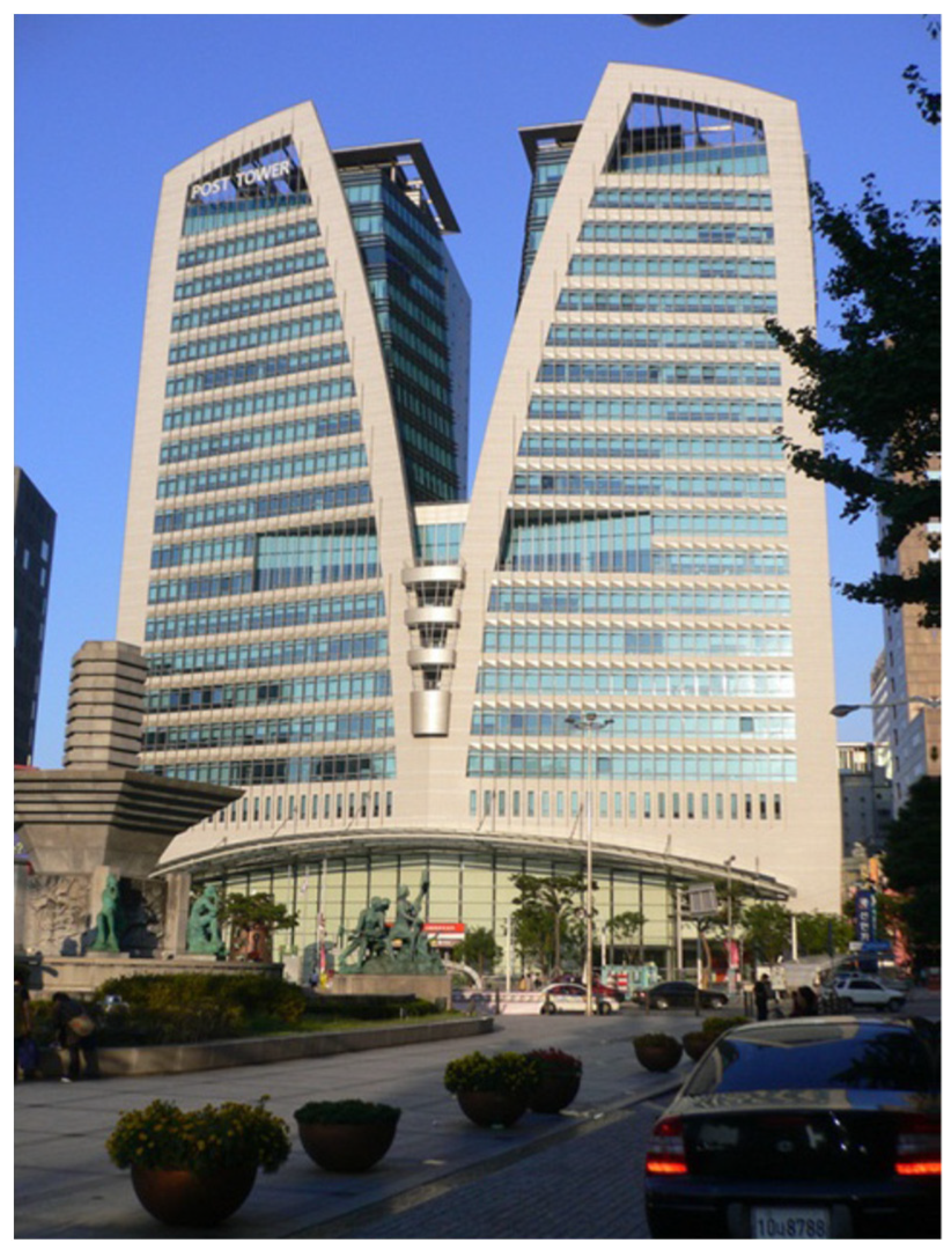

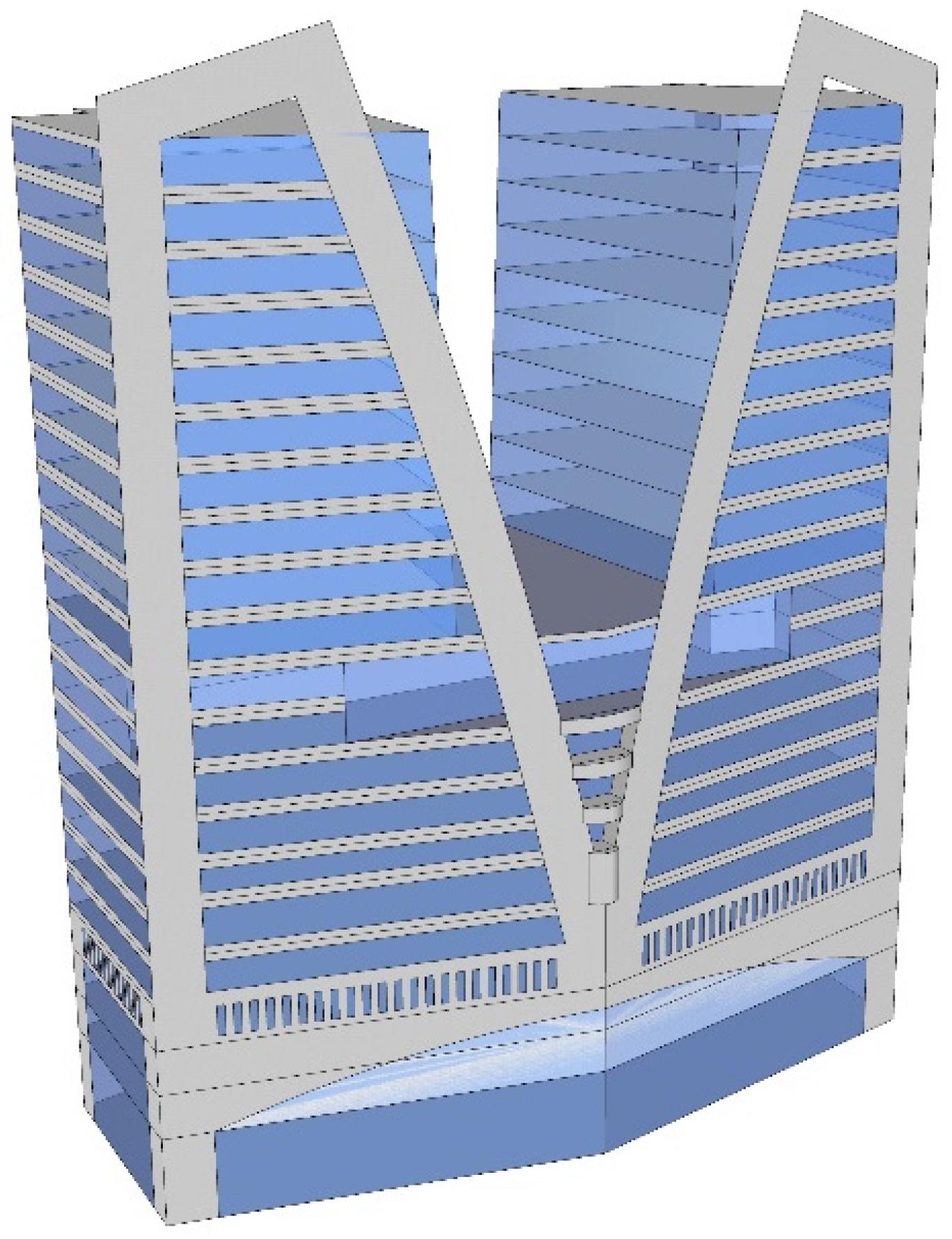
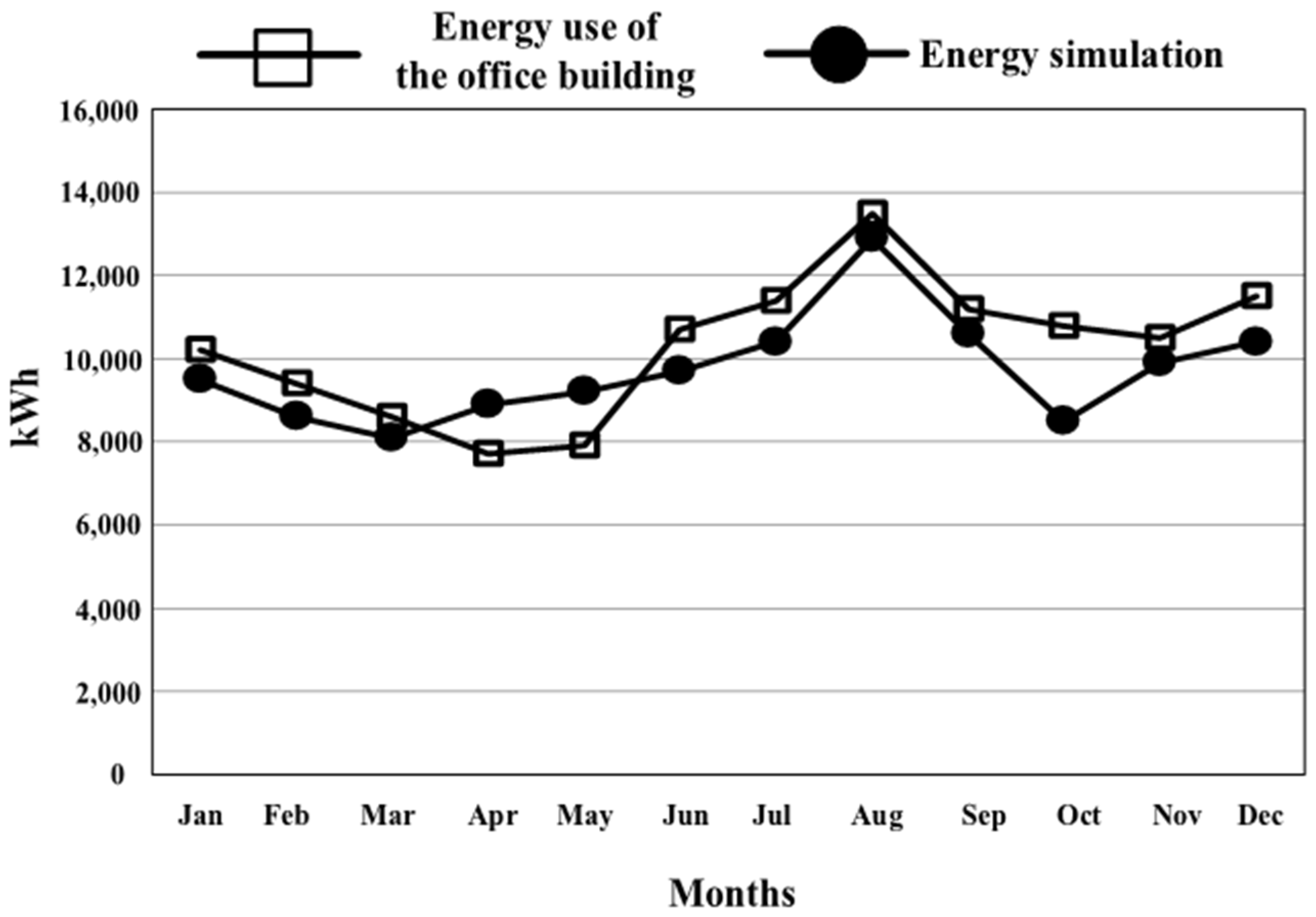
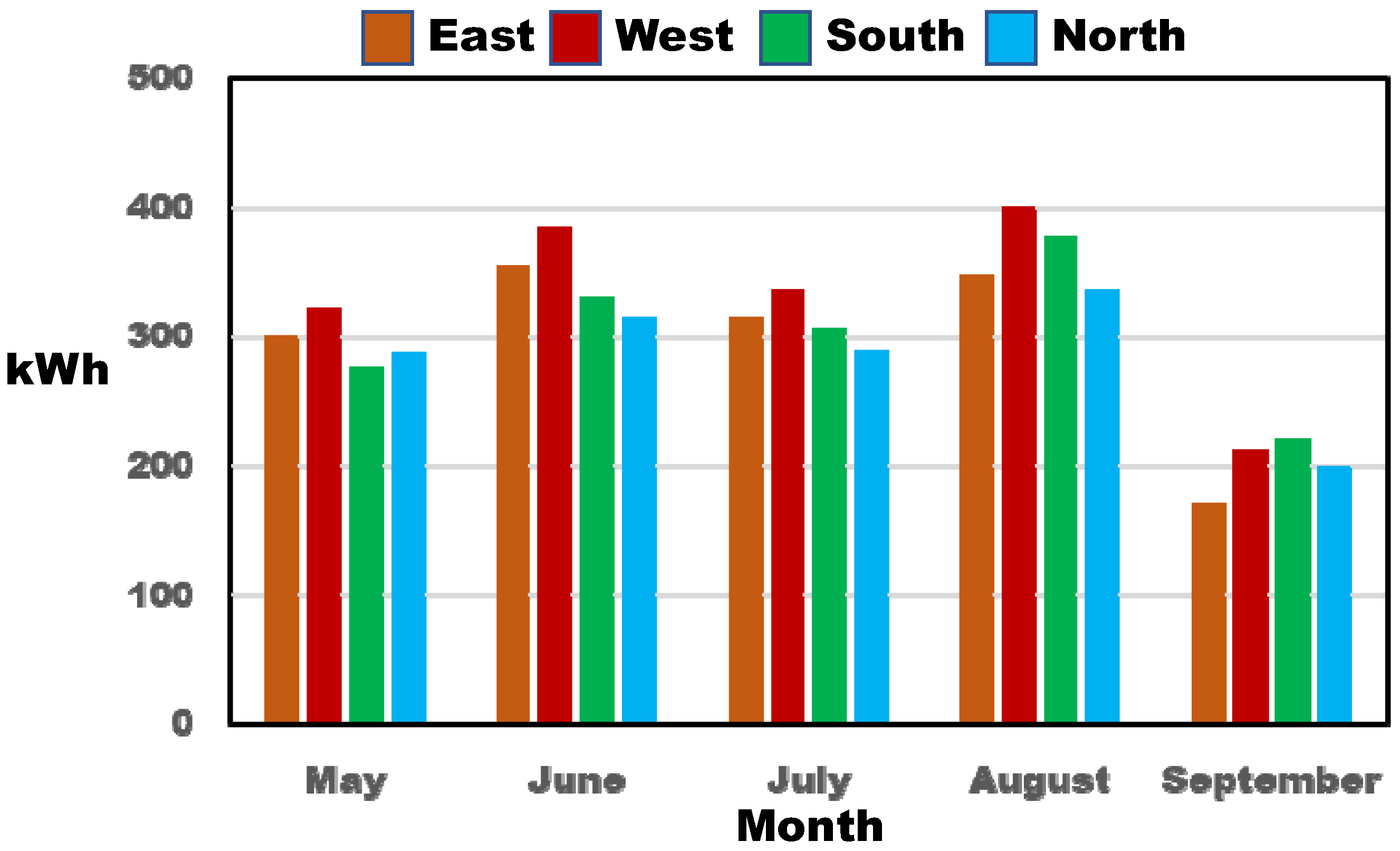
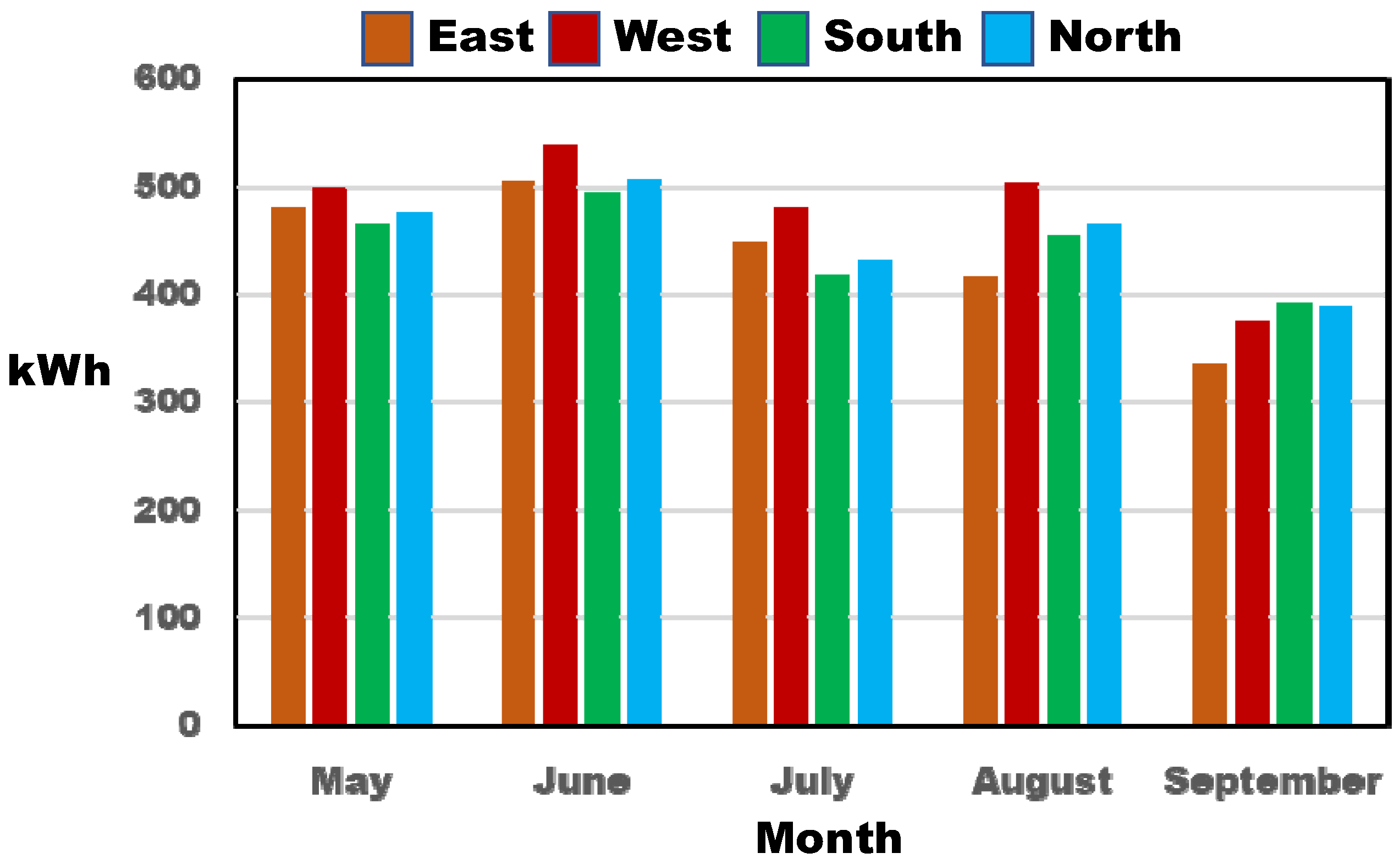
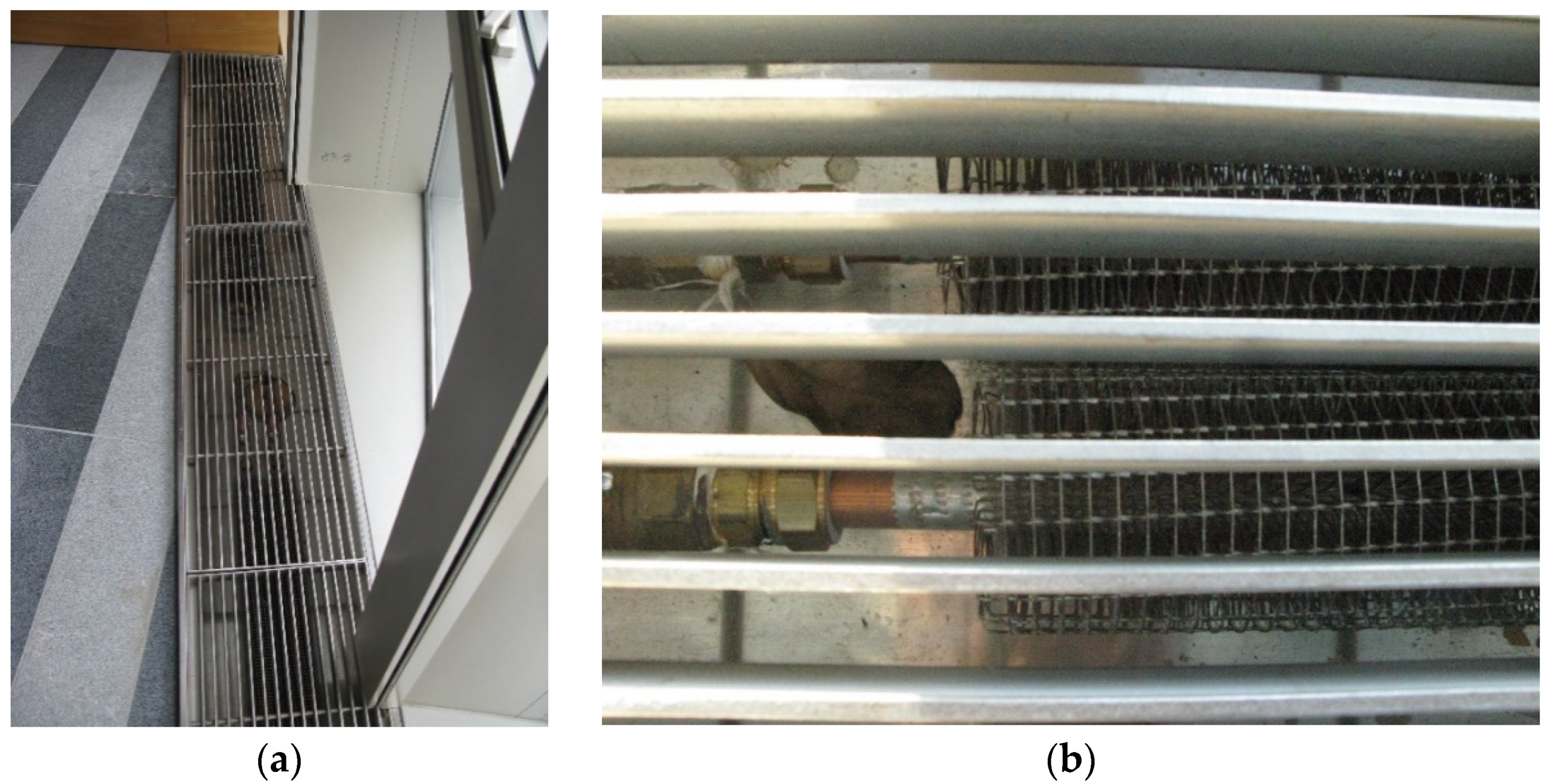
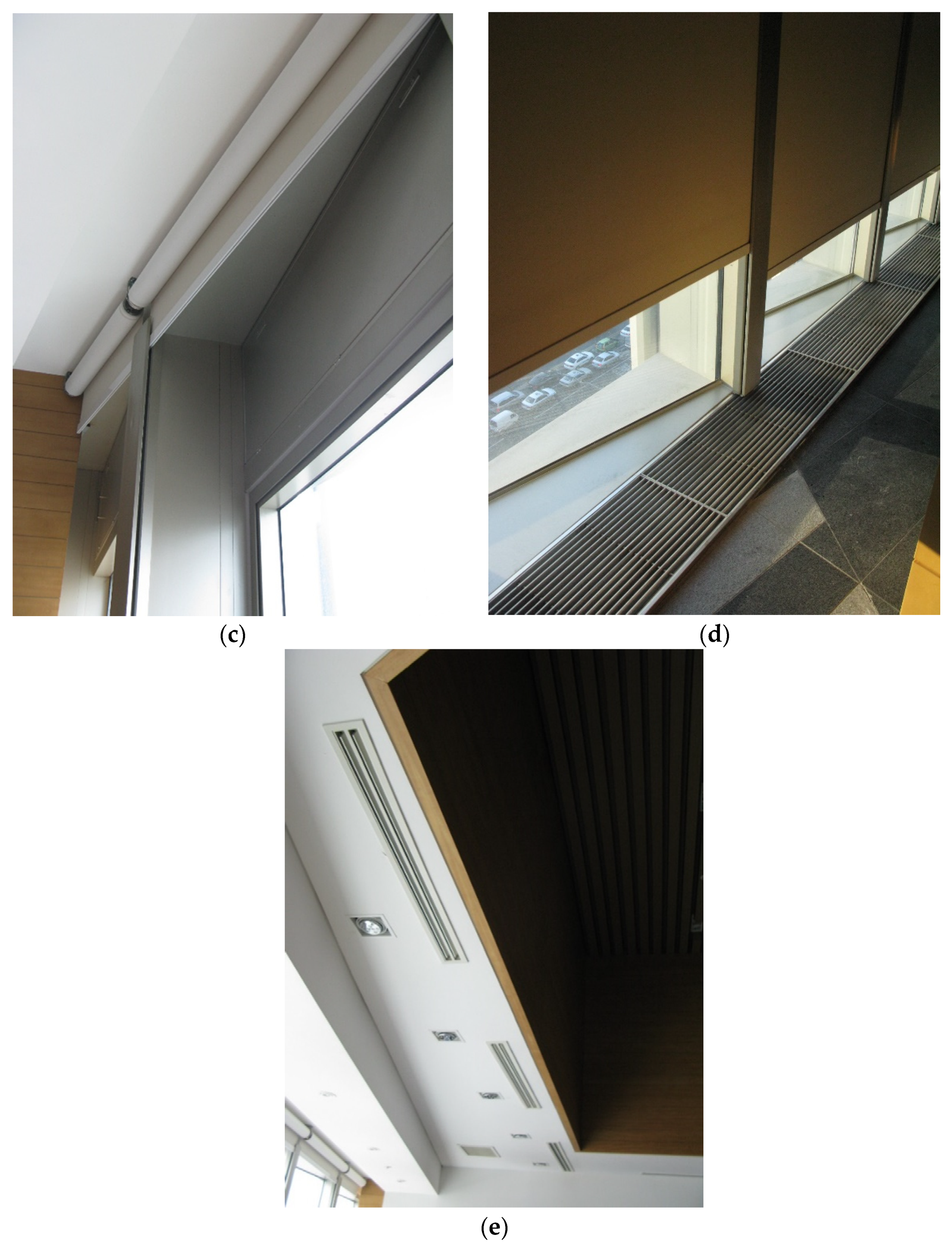
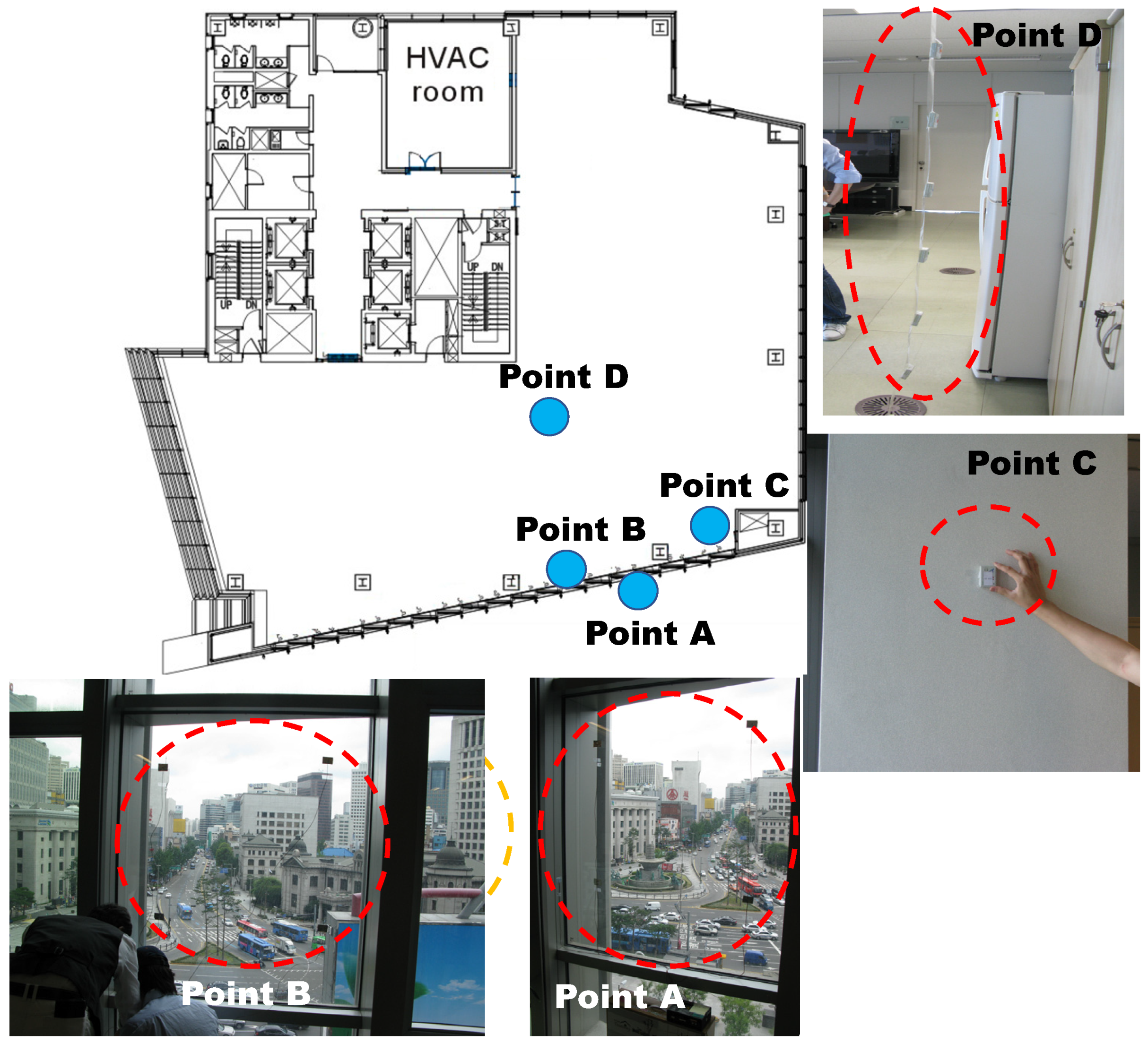
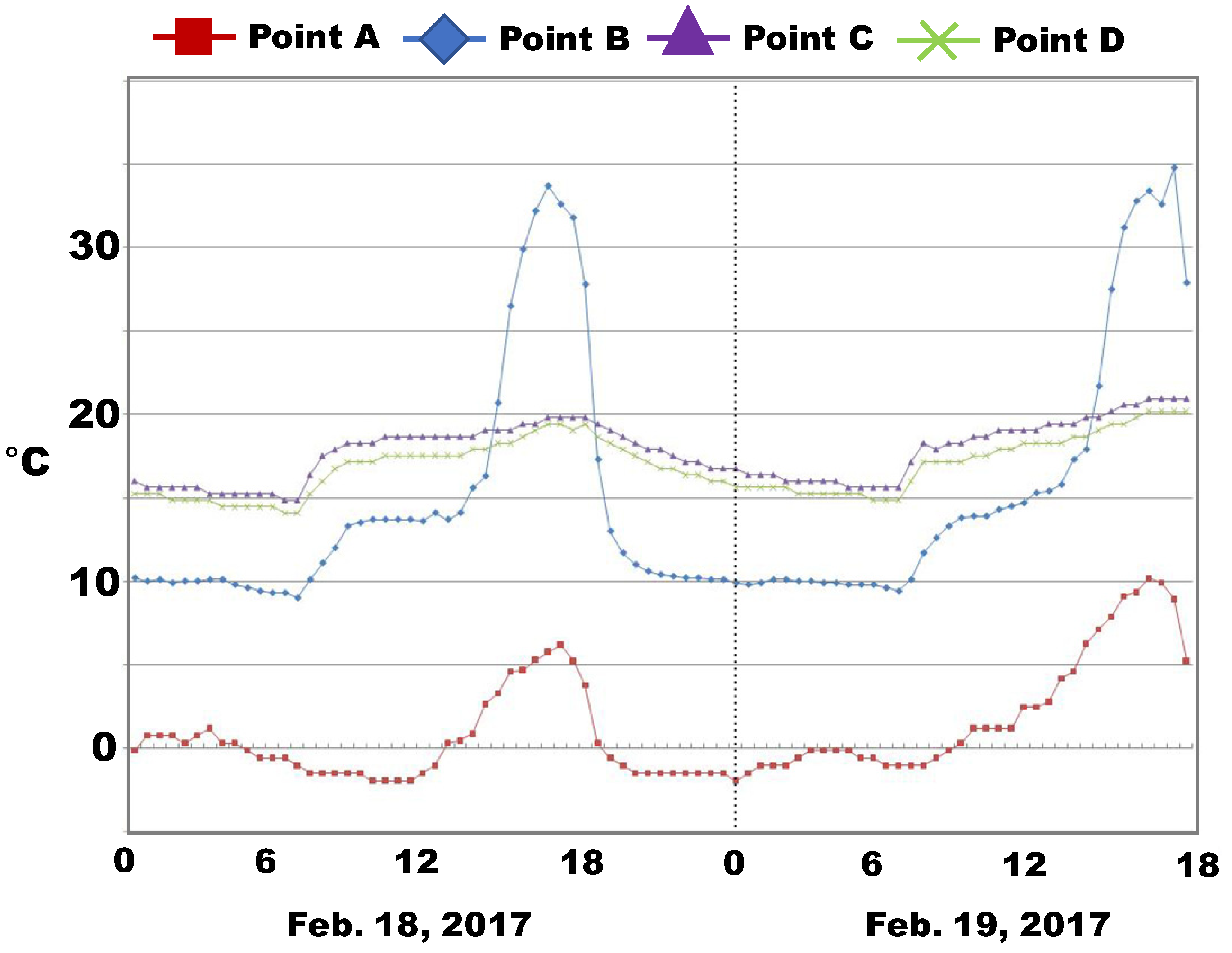
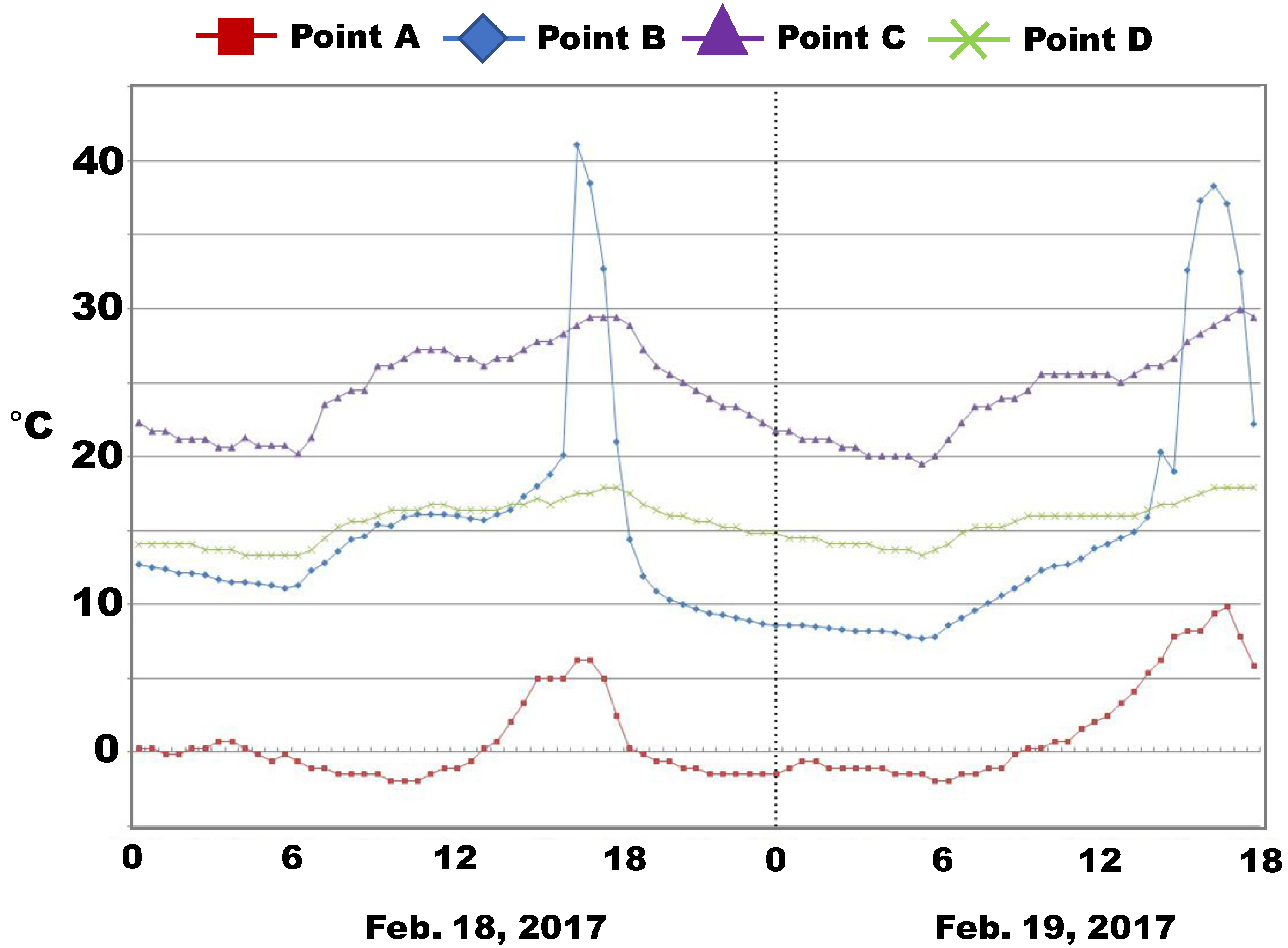
| Building | Specification |
|---|---|
| Location | Junggu, Seoul, South Korea |
| Floors | 21 floors (on the ground) and 7 floors (below ground level) |
| Usage | Office: 1st–21st floor, 2nd basement floor Parking: 1st basement floor, 4th–7th basement floor Exhibition: 3rd basement floor |
| Year constructed | 2007 |
| Envelope system | Low-E coating double glazing system with reinforced concrete & steel-framed structure |
| Gross floor area | 72,718 m2 |
| Mechanical system | Screw chillers, turbo refrigerators, steam boilers, the packaged terminal heat pump, and air barrier systems |
| Component | Specification |
|---|---|
| Envelopes | Roof: 0.12 W/m2K External wall: 0.35 W/m2K Internal wall: 0.136 W/m2K Windows: 1.8 W/m2K |
| Calculation period | Summer: May–September |
| Weather | TMY weather data of Seoul, South Korea |
| Cooling temperature | 26 °C |
| Lighting | 13.33 W/m2 |
| Air change rate | 1.2 ACH |
| Equipment | 8.06 W/m2 |
| Window System | Specification |
|---|---|
| Glazing | 24 mm Low-E coating on tinted glass |
| SC | 0.49 |
| SHGC | 0.43 |
| Month | Energy Consumption (kWh) | CV(RMSE) (%) | ||
|---|---|---|---|---|
| The Reference Office Building, 2017 | Energy Simulation | Difference | ||
| January | 10,200 | 9500 | 700 | 1.59 |
| February | 9400 | 8600 | 800 | 1.82 |
| March | 8600 | 8100 | 500 | 1.14 |
| April | 7700 | 8900 | −1200 | 2.73 |
| May | 7900 | 9200 | −1300 | 2.96 |
| June | 10,700 | 9700 | 1000 | 2.28 |
| July | 11,400 | 10,400 | 1000 | 2.28 |
| August | 13,500 | 12,900 | 600 | 1.37 |
| September | 11,200 | 10,600 | 600 | 1.37 |
| October | 10,800 | 8500 | 2300 | 5.23 |
| November | 10,500 | 9900 | 600 | 1.37 |
| December | 11,500 | 10,400 | 1100 | 2.50 |
| Month | East (KWh) | West (KWh) | South (KWh) | North (KWh) |
|---|---|---|---|---|
| May | 301 | 322 | 278 | 289 |
| June | 355 | 385 | 331 | 315 |
| July | 316 | 338 | 307 | 290 |
| August | 348 | 401 | 378 | 338 |
| September | 172 | 213 | 222 | 200 |
| Total | 1492 | 1659 | 1516 | 1432 |
| Month | East (KWh) | West (KWh) | South (KWh) | North (KWh) |
|---|---|---|---|---|
| May | 482 | 499 | 465 | 477 |
| June | 506 | 538 | 495 | 507 |
| July | 449 | 481 | 418 | 432 |
| August | 417 | 505 | 456 | 466 |
| September | 336 | 375 | 392 | 389 |
| Total | 2190 | 2398 | 2226 | 2271 |
| Model | Temperature Range | Accuracy | Limits of Error |
|---|---|---|---|
| Type K Thermocouple | −270 °C to 1260 °C | ±2.2 °C | ±1.1 °C or 0.4% |
| HOBO H8 | −20 °C to 70 °C | ±0.7 °C | ±3 K |
Publisher’s Note: MDPI stays neutral with regard to jurisdictional claims in published maps and institutional affiliations. |
© 2022 by the authors. Licensee MDPI, Basel, Switzerland. This article is an open access article distributed under the terms and conditions of the Creative Commons Attribution (CC BY) license (https://creativecommons.org/licenses/by/4.0/).
Share and Cite
Lim, T.; Yim, W.-S.; Kim, D.-D. Analysis of the Thermal and Cooling Energy Performance of the Perimeter Zones in an Office Building. Buildings 2022, 12, 141. https://doi.org/10.3390/buildings12020141
Lim T, Yim W-S, Kim D-D. Analysis of the Thermal and Cooling Energy Performance of the Perimeter Zones in an Office Building. Buildings. 2022; 12(2):141. https://doi.org/10.3390/buildings12020141
Chicago/Turabian StyleLim, Taesub, Woong-Seog Yim, and Daeung-Danny Kim. 2022. "Analysis of the Thermal and Cooling Energy Performance of the Perimeter Zones in an Office Building" Buildings 12, no. 2: 141. https://doi.org/10.3390/buildings12020141
APA StyleLim, T., Yim, W.-S., & Kim, D.-D. (2022). Analysis of the Thermal and Cooling Energy Performance of the Perimeter Zones in an Office Building. Buildings, 12(2), 141. https://doi.org/10.3390/buildings12020141





